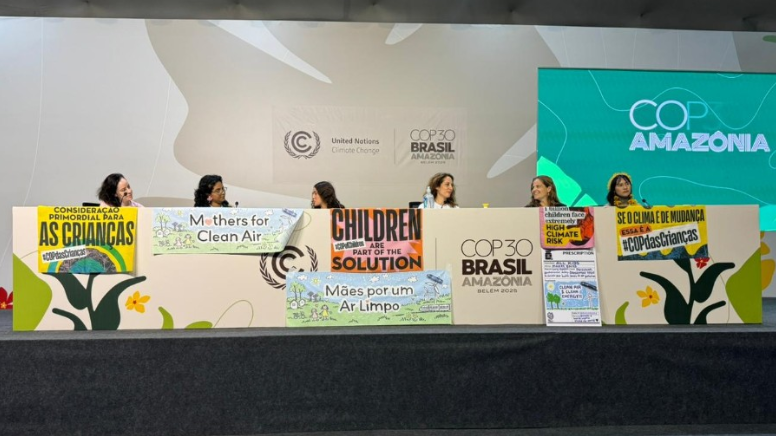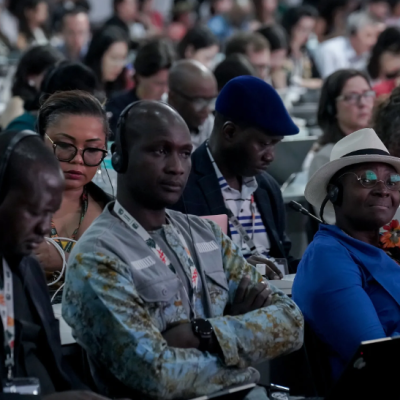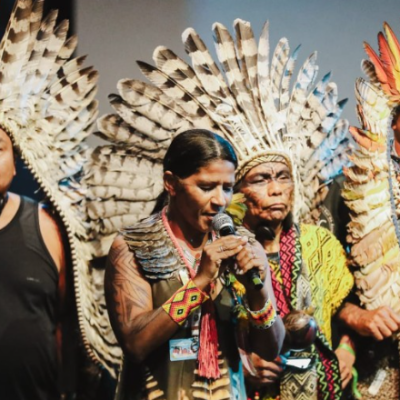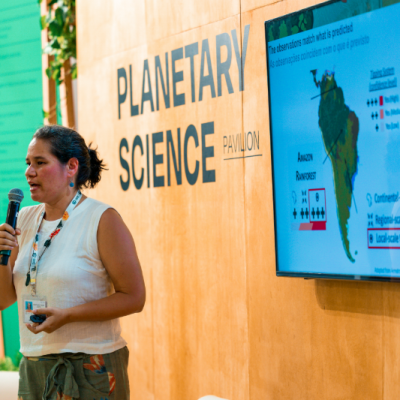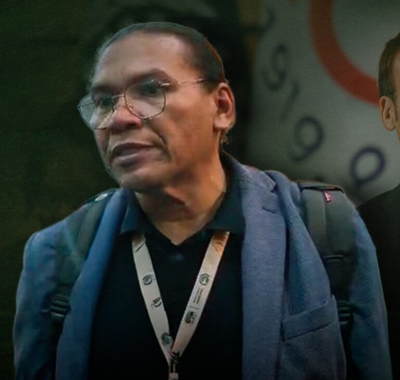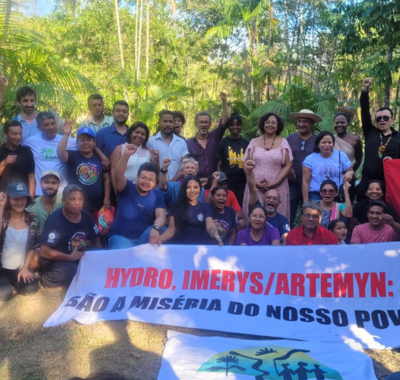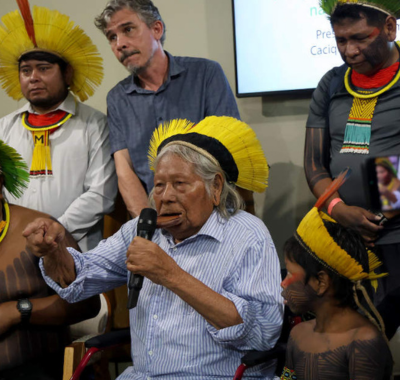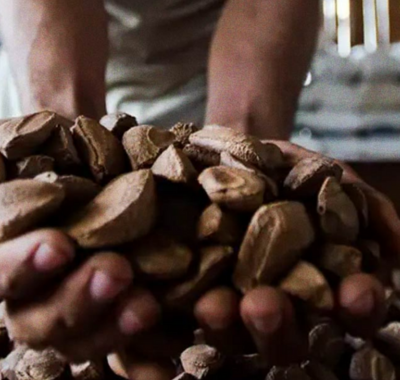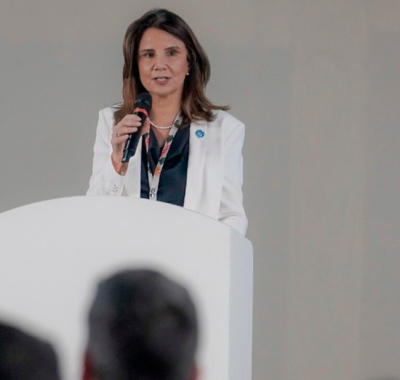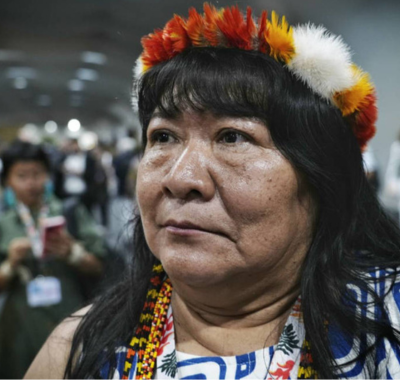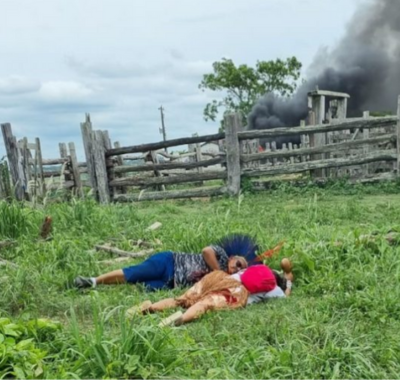A panel organized by the Alana Institute brought together mothers, young people, and activists who are transforming affection into action in the face of the climate crisis.
Text by Samantha Mendes. Edited by Carla Fischer.
They came to COP30 bringing more than just speeches; they presented concrete experiences on how the climate crisis is already affecting the daily lives of children and mothers in different parts of Brazil. At the panel organized by the Alana Institute in partnership with the global network Our Kids Climate, participants from different places – from the Amazon to Southern Brazil – discussed the role of childhood and youth in responding to the climate emergency. The debate, centered on protection of rights, stressed that new generations do not want to be remembered only in promises for the future; they are already at the center of the consequences and actions of the present.
The session began with a speech by Maya Mailer, co-founder and co-director of the Mothers Rise Up movement and member of Our Kids Climate. “We live in a polarized, sometimes frightening world, but we bring a superpower to this COP – the power of love and care that we have for our children and for all children,” she said.
Among the testimonies, Mariana Menezes, a mother, a businesswoman and a member of the Families for Climate movement, stood out for her account of the floods in Rio Grande do Sul, which affected several cities in May 2024 and left thousands homeless. “When I was rescued by a helicopter from the roof where my family and I were trapped, I felt anger. Anger at realizing how unprepared we are to face the climate crisis,” she recounted.
A resident of Eldorado do Sul, one of the most affected cities, Menezes described the human and material losses caused by the disaster and criticized the slow pace of public responses. “We paid the price of the crisis with the suffering of our families and also with what we hold most precious: our hope. I’m still angry because the changes are not happening at the speed demanded by reality,” she said.
Also participating in the panel, young Indigenous woman Taissa Kambeba, 15, from Mato Grosso state, presented a perspective from traditional territories. Attending her third climate conference, she recounted growing up witnessing her parents’ activism. She now works to advocate the demarcation of her territory.
“Since I was little, I’ve learned to fight. I face racism when I leave my territory to study, but I continue to resist because I want future generations not to go through what I went through,” she said.
Taissa Kambeba highlighted the importance of keeping her people’s language and culture alive, which are often threatened. “They’ve said that our people and our language had disappeared, but we continue to exist. The forest is my territory, and climate change has everything to do with it. I’m here to remind everyone that resisting is also a way of existing.”
From another point in the Amazon, Laís Fleury, Director of Institutional Relations at the Alana Institute, offered a reflection on the challenges faced by families and children in Amazonian cities, where environmental impacts are also intensifying. As the mother of Elena, she described the contradiction of living surrounded by rivers and not being able to enjoy them.
“My daughter may never be able to play in the waters where I grew up. Almost all of our rivers are polluted, and even the air we breathe is of poor quality. The worst part is that we don’t have enough data to measure the impact of this, and without data, we can’t demand rights,” she said.
Fleury defended the right of Amazonian children to a healthy environment and highlighted the importance of local mobilization and mothers’ role in the changes. “Being here is a way of making sure that the urban Amazon is also heard. We want clean air, clean rivers, and the right to keep our relations with nature alive.”
Next, 18-year-old Catarina Lorenzo from Bahia, a member of the University of Florida’s “Children for Nature Fellowship” program, highlighted the role of family and new generations in climate activism. “Age, gender, or background do not matter. If we dream, we can make it happen. I’m here because my mother taught me to act for myself and fight for what I believe in.”
For her, the future of climate policies depends on listening to children and young people and effectively including them in decision-making spaces. “We are the most affected, but we are also part of the solution. We want to be seen as a priority in decisions.”
Children and youth representation goes beyond symbolism
After the panel held by the Alana Institute, Laís Fleury spoke analytically about what has changed in the participation of children and adolescents in climate conferences, and the importance of youth participation and the agenda for the conference.
“I think that children’s participation in this COP is becoming increasingly active. Today we have 1 billion children living in countries at extreme risk. We mapped it and 126 children are participating, and I think we already have some milestones that point out that this is the COP of children.”
Beyond the statement, the context confirms the change: research shows that 56 of the 64 countries that submitted their Nationally Determined Contributions (NDCs) formally mentioned the rights of children and young people, that is, about 88%. In addition, in Brazil, there is institutional recognition that children and adolescents are a priority in climate adaptation policies.
Fleury also emphasized that, in Brazil and around the world, children should stop being seen only as victims of the climate crisis and start being put forward as agents of solution. “Children are subjects of rights. They are not only impacted; they also need to be part of the solutions. They have a lot to say, they have a lot to share, and they are part of the solution.”
This statement gains strength when considering that, in the previous cycle of climate commitments, the presence of children and youth in drafting national plans was not very systematic. The progress made indicates that, at COP30, there is a more favorable environment for the voices of children and adolescents to move from the audience to the decision-making table.
Girls at the center of the climate solution
The increased participation of children and youth pointed out by Fleury also resonates in a parallel movement: increasing presence of girls in climate decision-making spaces. During the panel, Déborah De Mari, founder of Força Meninas (Go Girls), stressed that gender inequality manifests itself strongly in climate emergencies, affecting girls in vulnerable situations more severely.
“Girls will be more impacted by the climate crisis, especially those living in vulnerable contexts. But seeing girls aware of their territories and willing to think of solutions is crucial for creating new futures,” she stated.
For De Mari, including girls in environmental debates is essential not only for representation, but also because it broadens the range of possible solutions. “It’s important that they are listened to so that other girls also recognize themselves as belonging to their territories and as agents of change and transformation,” she explained.
Força Meninas develops training programs aimed at public schools, focusing on science, technology and innovation, to create concrete opportunities for social and economic inclusion. “Raising awareness is not enough; we must create opportunities. Girls are not at the center of the crisis; they are at the center of the solution,” she concluded.
Together, these voices reaffirm that the children’s COP is also the girls’ COP, a conference where care and equity are consolidated as a core part of the solutions for the planet.
This report was produced by Amazônia Vox, through the Collaborative Socio-environmental Coverage of COP 30. Read the original report at: https://www.amazoniavox.com/noticias/view/461/a_cop_das_criancas_maes_e_meninas_mostram_que_o_futuro_nao_pode_esperar

